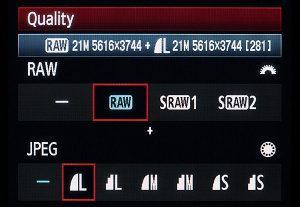Shooting in JPEG vs RAW?
In today’s blog, I’m going to talk about the advantages and disadvantages of shooting in JPEG vs RAW format. A JPEG is a format that compresses image files. This format is very favorable to any device that has a screen on it can view the JPEG image. The RAW image format has processed data from the image sensor in a camera, image sensor, or motion picture scanners.
To change your camera settings to JPEG or RAW follow these steps below:
- Go to menu
- Select the first selection highlighted (Image Quality)
- Select from either JPEG or RAW (Highlighted in red)


Advantages of RAW:
- Higher bit depth: Able to store more color information.
- More dynamic range
- This format applies lossless compression so your image won’t have any artifacts.
- All of the camera metadata is stored.
Disadvantages of RAW:
- RAW files are larger file sizes compared to JPEG.
- Post processing is required using this format.
- Software to view this file isn’t always available.
Advantages of JPEG:
- Smaller file sizes
- More flexibility for image quality and size. Able to change the level of compression as well
- Software to view is much higher.
Disadvantages of JPEG:
- Detail is lost in your final image, and at times are visible artifacts left behind.
- Max color depth of 8 bit. Some colors the camera captures are not presented in your final image.
- This file has little to no dynamic range of its data.
- Irreversible processing.
JPEG is a compressed image format, that takes original data and condensing the file, so it takes up less storage. There is a loss of quality to your image when shooting in this format. While RAW is a non-compressed image format, that offers a lot of advantages over JPEG. Overall if you are deciding which format to use, I would highly recommend shooting in RAW format.